A lot of people are growing increasingly concerned about using chemicals in their yard in order to treat weeds, which is why we put this extremely extensive guide together on how to kill weeds naturally.
In it, we’ve also combined a lot of natural homemade weed killers you need to know about that can help keep your garden beautiful, just the way you want it.
When you choose to use natural ways to get rid of weeds, you’re not using chemical pesticides that would otherwise pollute the environment when you’re done with them, and doing it like this is just one more way to go green and help the environment. Yay for you! Before starting out, we want to help you better understand some of the things you’re up against, meaning what are the weeds you’re trying to get rid of in your garden.
If you simply want to get to the full list of natural weed killers without reading the article, you should just jump to the bottom of it straight away, which is where we included a list of them all. Throughout the article we’ve included how you can use most of the different options and how to do so effectively.
Common Types
While we wish it was possible, it’s not possible to avoid weeds and it takes effort to keep them at by. If you’re strategic about it, it won’t be too much of a hassle though. You can see a list of the most common weeds right below. You can also either try getting rid of them yourself or call in a landscaper to help you in the process.
These are the most common types that you’ll run into in your yard.

- Dandelion – they’re hollow in the middle, and you’ve definitely seen their seeds fly away. When you were a kid, you probably had fun blowing the seeds onto other people. The flowers that it produces are yellow, and they grow the entire year.
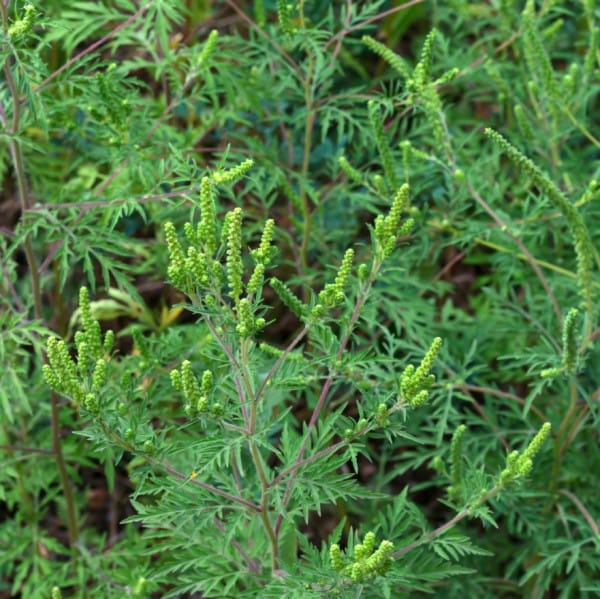
- Common ragweed – these look like fern and they’re hairy. Its flowers are yellowish and green, while producing a horrifying number of seeds every season – 60,000.

- Crabgrass – its leaves are pointed and flat with short stems. The flowers have little spikes on them.
- Daisy weeds – extremely prevalent in yards. Their leaves are white while the part in the middle is yellow.
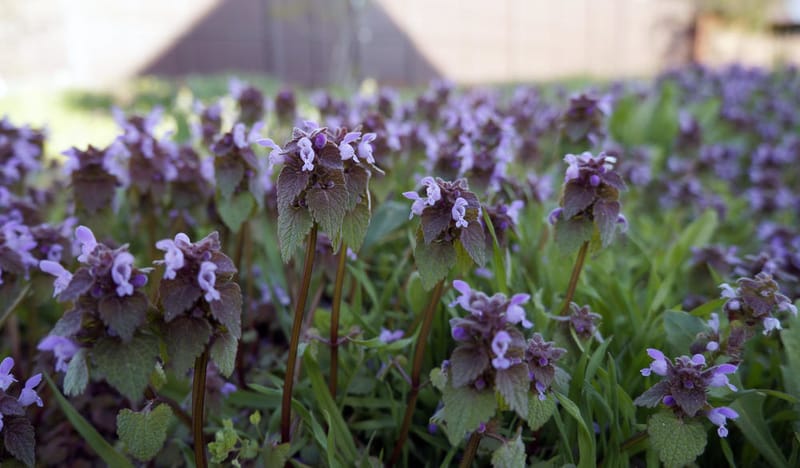
- Ground ivy – it spreads extremely fast with its blue and violet shaded flowers.
- Selfheal – while you probably didn’t know it, this weed is closely related to mint. When it comes to your garden, it will almost feel like it takes it over in the timre it takes for you to blink.

- Thistle – This is very common in the garden too. The leaves are prickly and it makes a purple flower which can also be pink.
- Yarrow – Clusters of flowers that come in different colors, although most often being white.
Plant and Weeds Identification (and Apps)
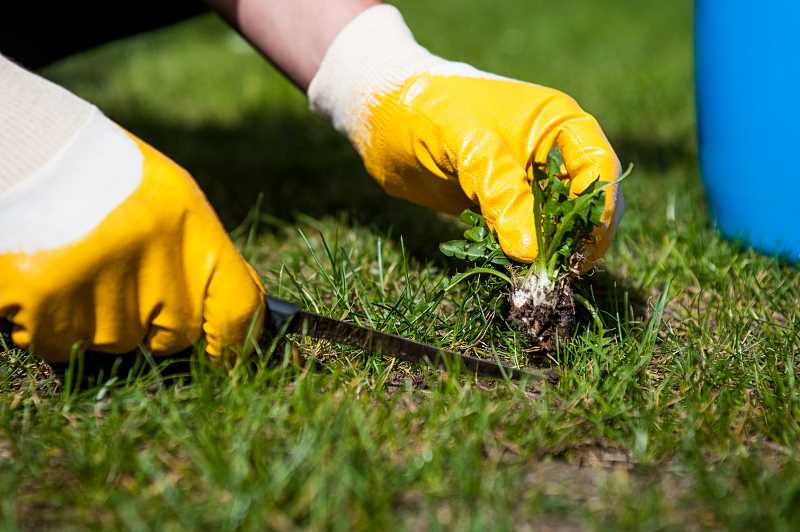
We wouldn’t truly be embracing technology if we didn’t mention that there are certain apps out there that help in determining what plant it is you’re dealing with, and anything that will make it easier for you to find and remove the weeds, we’ll be happy to help promote it. In fact, someone put together an article on that very topic of plant identification apps.
Other apps include PlantSnap and PictureThis. Admittedly we haven’t tried either of the apps ourselves, but given their positive ratings on the App Store, we believe they work. Both of them having at least 4 out of 5 stars, and PlantSnap having more than 8,000 ratings at the time of the writing of this article.
The last thing you want as a homeowner is to try and have a beautiful garden that ends up as nothing else than just one big collection of weeds. They’re annoying to look at, and they’ll suck all the nutrients out of the soil, not allowing other things to grow that you may in fact wish should be growing there. They’re stubborn and you may just have the impression that they won’t leave you a minute’s rest.
Identifying them is the first step in getting rid of them.
There are 3 major categories of weeds and how you’ll tackle them depends on the type of weed. The 3 categories include annual weeds, lawn weeds and perennial weeds.
Annual weeds itself will last a growing season only, but the following year all the seeds left the previous year will just start growing. The types of annual weeds include groundsel, chickweed and fat hen (which gets up to 4 feet tall with its vertical stem).
Lawn weeds include plantain, dandelions and daisy. Daisy being the most popularly known among them
Perennial weeds grow deep roots and without getting rid of those, you’ll see them coming back every single year, and they can be very hard to get rid of. The different kinds include ground elder, couch grass and broad-leafed dock.
Controlling The Weeds

While you may have a desire to keep your lawn free of weeds, it won’t be possible, and you’re better off admitting to yourself that while you can do a lot to minimize its impact, it’s a battle you won’t win. What you ought to know is that growing a good lawn will also have a big impact on minimizing the amounts of weeds you get there, as both are fighting for the space. Unfortunately, the lawn will usually tend to give up before the weeds do.
For one, you need to make sure that you keep your lawn well-watered which could include the installation of a lawn sprinkler system, which in turn also could be beneficial for the other plants you’re trying to keep.
When you do see the weeds, you should do something about them, although you can expect them to come back. The first step is to inspect the lawn and figure out if there are any spots where the weeds seem to prevail, or where the lawn is struggling. It’s also a matter of staying alert during the process of lawn mowing.
It’s an old school tactic and it works, as well as been a natural solution – you need to pull the weeds when you see them. It’s easier if you carry a little bucket around with you so you have somewhere to throw them so that you don’t just end up putting them in the corner where they’ll come back. Focus especially on the ones that are setting seeds, since the problem multiplies when those seed get access to your lawn.
[bctt tweet=”Maintaining a lawn without a lot of weeds in it means you’ll need to inspect it frequently and pull the weeds out.” username=”ContractorHelp”]
See this video for the right way to pull them out of the earth.
The inspections should especially be done when it has just rained and the soil is wet, which makes it a lot easier to do. Making the lawn wet can also simply be done using either a sprinkler or a hose and once it soaks into the soil, that’s the time for you to remove them.
The advantage of working on getting rid of them before they’ve been there a long time is that they won’t have roots that are as hard to handle and pulling them will be easier. If you do plan on using herbicides, these are also more effective against younger plants. Older ones become a lot more resistant to chemical solutions.
When there are a lot of weeds, you may want to get tools to help you in pulling them, which doesn’t have to cost you a fortune. Here’s a great selection of the tools for you to consider. The more of the root, especially the tap root, you’re able to remove, the less likely it is that it will come back. They will simply re-sprout if you don’t pull enough of it out of the ground.
What Causes Them To Grow?
There are things that will cause weeds to grow significantly, although it is also very dependent on what type you’re dealing with.
Some of them will grow if there’s a good amount of water, or if there’s basically too much water, and this includes crabgrass, goose grass and others. During autumn their seeds are spread across the lawn and when the temperature of the soil geets to 55 or so degrees the following year, they’ll start growing.
A lot of water in that period of time just speeds up the process of them growing If you’re keeping your lawn less than 2 inches, there’s also a bigger chance that you’ll be inviting them in.
Perennial weeds are common in overwatered lawns with little drainage, and you may just consider improving the drainage situation of your home to avoid this. By identifying the most common types of weeds in your yard, you can take measures to affect what is causing it to grow, thereby minimizing the risk that it will do so.
How to Kill Weeds Without Killing Flowers
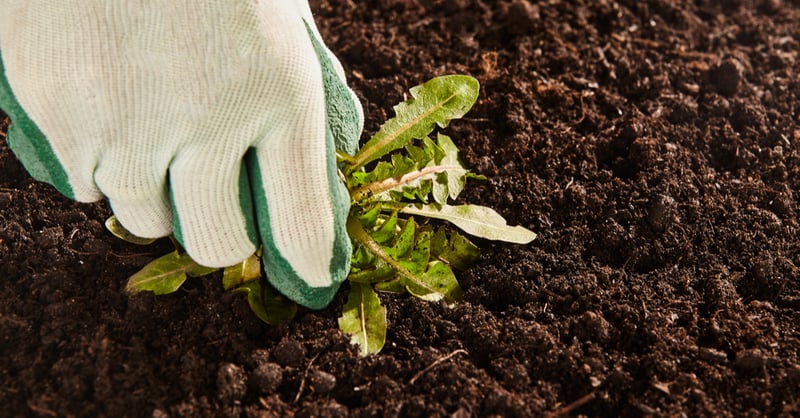
When people try to get rid of weeds, they don’t want to accidentally kill the flowers too, which they may have spent a lot of time trying to get to actually grow. This is even more so the case if you have a vegetable garden that you’re growing. Weeds generally don’t tend to be as nice as to take effort to grow away from the plants you love so dearly, so you’ll often find yourself in a situation where you need to address them in inconvenient spots.
Again, the most effective way is to identify the specific type of weeds and then targeting that specific kind.
Cornmeal can be spread in a thin layer in your garden before the flower garden has had time to establish itself yet which keeps the weeds from germinating.
Vinegar has a lot of purposes in your home, including helping get rid of weeds. Use white vinegar in a spray bottle directly on the weeds to get rid of them. It should only take a relatively short amount of time before they start being affected, and it’s also a natural way to address the issue. When using vinegar, you will want to be careful to avoid the plants that you don’t want to get rid of. When you revisit the weeds the following day, the vinegar should have had enough time to do its work.
Using baking soda is also a natural weed killer and can be spread where the weeds are, although again you should keep it away from the flowers. When your driveway has cracks in it, you can use this to get rid of them, although you may also want to repair and seal the driveway to keep it from further deteriorating. The baking soda affects the pH value of the soil, which is why the weeds won’t survive.
Using saltwater is also a natural weed killer and an easy one too. Just boil a couple of cups and put in a cup of salt, which will be poured onto the weeds. Make sure that you don’t end up burning yourself transporting the boiling water.
- Saltwater – boil two cups of water then pour a cup of salt in it. Then pour the mixture directly into the weeds. This will sure kill them all. You just have to be careful with this method since you will be dealing with hot water.
Using Vinegar

Vinegar is an environmentally-friendly option that won’t harm pets, humans or the ground water, which can’t be said about the chemical alternatives, although you may find the weeds coming back if all you do is pour vinegar on them. Here’s a more extensive guide on using vinegar to get rid of weeds.
Get a gallon of cheap vinegar. The reason we’re recommending the cheap stuff is because kind will simply be more expensive, it won’t be more effective. Pour it in a bucket and mix it with a cup of table salt until the salt is dissolved. Add a tablespoon of natural dishwashing soap that will make the mixture more effective and put it in a spray bottle.
The best time to be spraying the weeds is when they’re dry and you should not be afraid to coat them in it but make sure to avoid spraying it on the surrounding plants, though.
You can simply store whatever’s left in a place where it won’t be accidentally thought of being something else and then bring it out again when the weeds need another round of the mix.
Wearing gloves might be an idea for people with sensitive skin since the pH value of it is around 2.5, which makes it pretty acidic. The gloves will ensure that your hands are feeling good even after treating the lawn with it.
Does Baking Soda Work?
While we briefly mentioned baking soda, it deserves its own section due to it being an inexpensive treatment to use too, however it may not always be the solution and before you go all overboard with it, test it out on a couple of the weeds there to see their reaction. It’s best when the weeds are a little bit wet before putting it on them, and then taking about the amount of baking soda that fits in a teaspoon and spreading it all over it, rather than simply putting it in the middle.
Try it out with the different types of weeds that you’re finding in your yard to see which ones are reacting to it. Treating cracks in sidewalks as well as previously mentioned driveways will benefit from this treatment. When it doesn’t manage to entirely get rid of the weeds, you should reapply it about 5 weeks later, and the best time for this treatment is either in the fall or spring while they’re growing.
The reason for doing it while the weeds are wet is also because you want it to actually get to the roots of the plant.
Salt

Salt is another natural weed killer and even if it sounds strange to use, it works, although the process should be done cautiously. The good thing about this product is that you can simply go to the kitchen and get it since all kitchens have it. Even if you need to go out and buy it, you can get salt for less than $1. It works by dehydrating weeds and their water balance, which is also one of the reasons that huge amounts of salt can be dangerous for humans.
It’s however only recommended for weeds that haven’t gotten to o established, or you may find yourself pouring large amounts of it on your lawn, which won’t do anything good for any of the plants you wish to plant there afterwards.
By mixing it with and dissolving it in water, you get a mixture that the weeds can’t handle, or at least the small ones cannot. The water to salt ratio in the mixture should be around 3 to 1.
Again, we cannot stress enough that this will also affect other plants if it gets to their roots, which is why you will want to only do it where the weeds are. What you can do if there are any plants that are too close is to water them well, which will help dilute anything that might have gotten to the roots of your desired plants, and you’ll thereby mitigate any potential damage that could have been caused by the salt treatment.
After you’re done, make sure to wash your hands thoroughly so that you don’t accidentally get the salt in your eyes.
Does Mulch Kill Weeds?

Mulch is a popular way to keep any unwanted plants from growing, because it blocks the light from reaching the soil as well as warming it up. However, if you want it to be successful, it takes a layer of roughly three inches. If you do that, seeds won’t manage to germinate and sprout and the weeds won’t start popping up, since it will take too much for the weeds to manage to get through the mulch.
There are different options for you to use for the process.
One option is to use pebbles and small stones which has the advantage over traditional mulch that they don’t end up getting broken down, and for vegetable gardens it’s more popular to make use of of straw. Grass clippings is also an option but some people not to use it because of what it looks like.
If you want something that looks good with all the advantages, bark is what you should be looking into since it’s also a natural material. Since it works by making sure that the sunlight doesn’t reach the soil, you will only want to use it where the things that you actually want growing there are sufficiently strong that they have already grown enough that the mulch won’t be an issue for them, since they, like the weeds won’t be able to get through the mulch at its earliest stages.
Will Ammonia Do The Job?
There are many different things that can be used against weeds, and as you’ve seen from this article, the mixture that you make does not even need to be an expensive one to make it be effective against weeds. Ammonia is another thing that can be used to get rid of wildflowers in the home, although you will need to be cautious when using it, if you choose to do so.
There are some precautions you can take, which includes diluting the ammonia by mixing amonia with water in a 2 to 1 ratio, since ammonia’s normal pH value is 11, which makes it a weak base. You can then use this mixture on a small part of your garden where the weeds are and seeing how they react. It can be sprayed using a spray bottle.
If it manages to get rid of the weeds, then use it on the other weeds in the garden. You should know that you might need to spray several times to get it to work.
Boiling Water
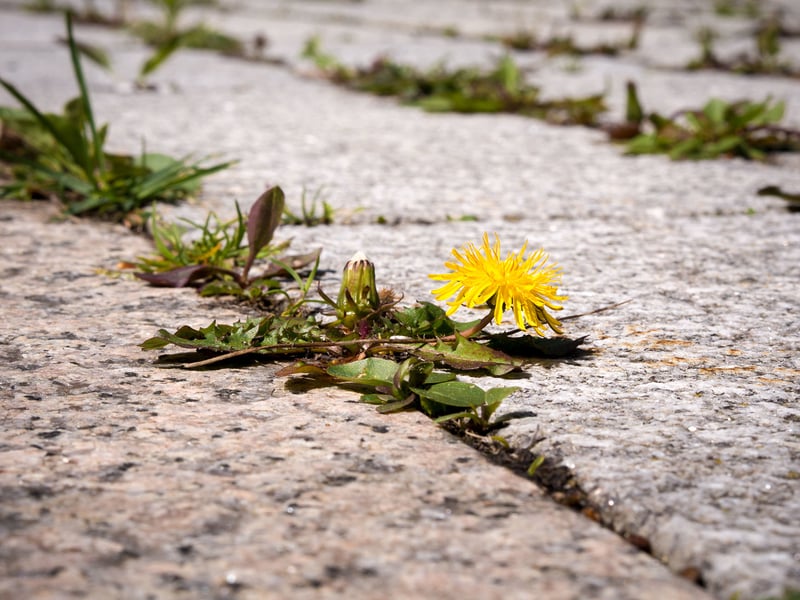
Boiling water is not specific to weeds but will work on all the different types of plant that it gets in contact with, which is why you’ll want to make sure to only use it on weeds that are clearly by themselves. It’s obviously a natural and very inexpensive option and can help get rid of annual weeds as well as perennial weeds. Being natural and non-toxic means that you won’t have to be afraid from pets or humans getting in contact with it after it’s been applied.
It can literally not get more natural than water. While we recommended baking soda for walkways and driveways, boiling water water will also work there.
It’s as simple as boiling the water and pouring it on those places that have weeds. For maximum efficiency you will want to use it straight away when the kettle stops heating it anymore. You want to scald the weeds, but you also want to do it carefully so that you don’t accidentally have it splash and it gets in contact with your skin either.
By cutting off the top of the weeds, it will make it even more effective. It should be poured a couple of inches above to minimize the amount of splashing.
While this be very effective, weeds with long taproots may keep sprouting if all of the roots weren’t scalded. If you make a hole as close to the weeds as possible and pour the boiling water in, it’s more likely to reach the entire root system while still being sufficiently hot to do the work.
Since the hot water also negatively affects the lawn, you’ll want to make sure you sow new grass immediately after to avoid a bare spot from appearing where unwanted plants get free access to blooming.
Even if it re-sprouts, the new weeds that end up growing there will be weaker than the previous ones and you should have gotten entirely rid of the weeds in that area after 2 or 3 treatments at most.
It’s obviously important that you handle the boiling water responsibly with all the necessary safety precautions, which includes how you pour it and wearing appropriate footwear that doesn’t accidentally let boiling water onto your feet.
Can Bleach Be Used?
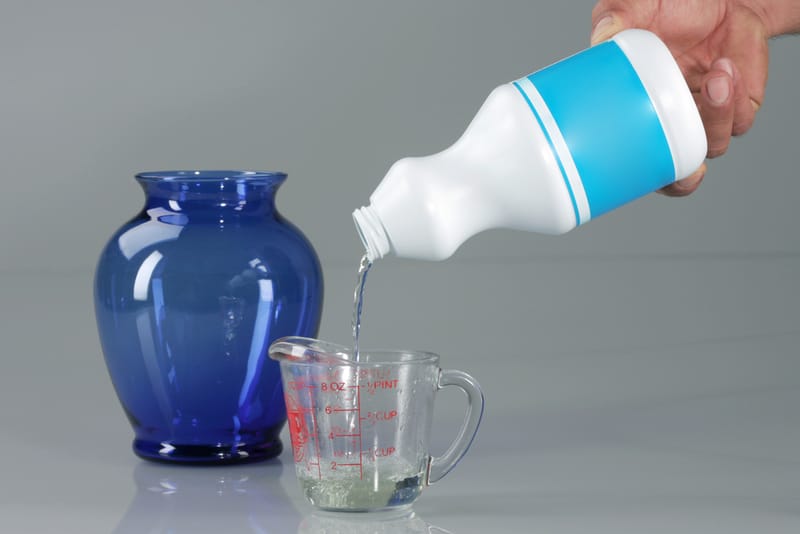
Bleach is a product that a lot of people have in their homes and it can be a good alternative to chemical herbicides if you’re not finding that any of the natural options are working as intended.
When the weeds are maturing which makes them harder to get rid of, you could need something a bit stronger, which is exactly what bleach is. Pouring it on the weeds will ensure that they’re very easy to pull out the following day and it doesn’t immediately leave the soil keeping them from coming back. It’s not very good for the soil if you intend to use it following the treatment, and you should be very careful in avoiding it splashing.
Bleach’s pH value is somewhere between 11 and 13 depending on its concentration which is why it will have the same effect as ammonia, and it will negatively affect the good plants if it gets in contact with them.
When it comes to using it against weeds, you will really only want to use it in some areas.
How to Kill Them In the Winter
The process of killing weeds in the winter is no different from the rest of the year, and if you tried one way to get rid of them and it didn’t work, you might want to find a way that is specific to the type of weeds you’re dealing with. If you have more types, you will need to find out what type each one is and use the appropriate methods required for that type.
When you effectively get rid of them in the winter, it might set you up for a much easier spring when then otherwise would start to thrive.
The earlier in the process you catch them in, the easier it will be to deal with the situation, so if you notice them, even if it’s winter. Be sure to get them out of yoru lawn at that point. Being proactive is like doing active home maintenance in that it will keep potential problems from getting so big they’re hard to deal with.
There are however some types of weeds that go dormant in the winter and it might be hard to spot them at that point and dealing with their roots.
Pet Safe Weed Killer for the Lawn

A lot of people have pets, and it’s naturally a concern that your dog, as well as your kids for that instance, do not get harmed during the removal of weeds. Your furry friends will thank you when you choose a natural solution to treat your lawn with. This can be boiling water, baking soda, sugar, salt or vinegar.
You’ll want to steer clear of harsh chemicals, and it’s the absolute best thing if you can deal with the situation with any of those.
Parks and other places that get sprayed with harsher chemicals will have warnings all over for good reason – because those things are not meant to be ingested, and both pets and kids are curious creatures that could unfortunately get harmed as a consequence.
These chemicals may even get absorbed through the skin. While it’s less worse than ingesting them, they will at the very least irritate the skin and quite possibly cause rashes.
Read more about dogproofing your home too.
If you do choose to go with a commercial option, you should contact a veterinarian first to hear what they have to say about it. The old school method of pulling them by hand is still one of the most efficient ones and you’re sure that your pet won’t get harmed from it. You’ll have to put some muscle behind it but it’s worth it for the sake of keeping everyone safe.
[bctt tweet=”Manually pulling the weeds is the safest way to get rid of them and good when you have pets.” username=”ContractorHelp”]
Boiling water is generally enough to handle it too, and your pet will appreciate you not using strong chemicals, and if not, salt will get the job done, as we previously talked about.
Natural Weed Killers
We promised you that we’d give you a full list of the natural weed killers available to you, and to summarize, here they are:
- Straw, used as mulch
- Mulch
- Taking their top off as soon as you can – this will keep them from spreading their seed which eventually will control the situation.
- A healthy lawn – while you may want to cut it shorter, it also just makes it easier for the weeds to pop up.
- Avoid digging – every time you dig, you leave a patch without grass on it, thereby inviting weeds to join you.
- Goats – yes, they’re actually being used for weeding.
- Putting them in food – surprisingly, a lot of weeds are edible, including young dandelions.
- Plant things that don’t allow them the light of day – you can do it with a lawn, but other things can be planted too to keep the weeds out.
- Using vinegar
- Creating a continuous edge by adding edging.
- Salt
- Fire – the same way boiler water will get rid of the roots because of heat, so will a weed torch.
- Boiling water
- Cover them – the same principle as with mulch, but if you cover them with newspaper for instance, they won’t get the sun that they need and eventually it will prevent them from surviving.
- Pulling them out
- Natural dish soap
- Lemon juice – the acidity helps get rid of them
- Getting chickens – chickens will get rid of them the same way that goats will – by eating them.
- Using strategic shade – weeds need sun so if you can place them in constant shade, they might not make it.